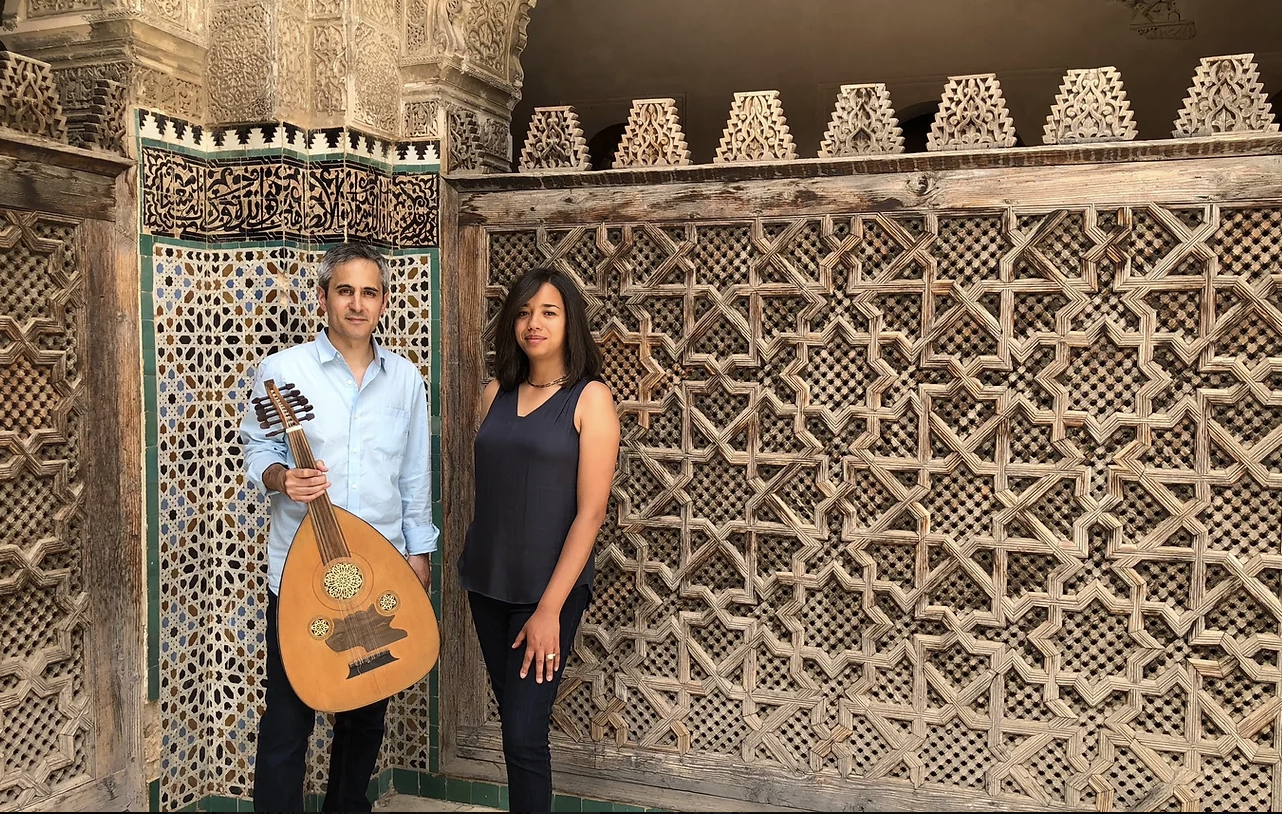Seffarine meets at the crossroads of southern Spain and northern Morocco
Singer Lamiae Naki and multi-instrumentalist Nat Hulskamp write original music to reflect what the two cultures might have sounded like if they had coexisted
Seffarine’s Nat Hulskamp (left) and Lamiae Naki.
Kay Meek Arts Centre presents Seffarine on November 30 and December 1 at 7:30 pm
FOR MILLENNIA, THE Pillars of Hercules marked the furthest extent of the Mediterranean world: fickle currents, unfavourable winds, and fear kept Bronze Age sailors from venturing into the wild Atlantic. Past the twin promontories of Calpe Mons and Jebel Musa only the bravest would go—and if they did, few returned to dispel the clouds of superstition that hovered over the Strait of Gibraltar. Once the Phoenicians breached that barrier some time before the 5th century B.C., however, the 14-kilometre gap between Africa and Europe was soon transformed into a major trade route, with improved vessels facilitating the exchange of goods, technologies, philosophies, and, most importantly, people.
It’s at this marine crossroads that the band Seffarine is located. Singer Lamiae Naki and multi-instrumentalist Nat Hulskamp came together as collaborators—and as a couple—because of their shared love of the linked traditions of southern Spain and northern Africa. Rooted in the Afro-Arabic culture of Morocco—and in the hammering rhythms of the metalworkers in her native Fes, whose souk gives the band its name—Naki has long been fascinated by Andalusian music, which has survived in North Africa thanks to the influx of Muslim and Jewish refugees that followed the rise of the Spanish Inquisition. Hulskamp’s path to the same sound is only slightly less straightforward: growing up in Portland, Oregon, his early love of the guitar led him to flamenco, and in turn he wanted to discover that music’s roots. The two met and immediately bonded in Fes, where Hulskamp was studying the guitar’s Arabic ancestor, the oud.
It was, the band’s bio suggests, love at first sight. The long love affair between Spanish music and Moroccan music has found it harder going, however, although the 400-year divorce between the two cultures has had the unintended consequence of different aspects of Andalusian music surviving and mutating in each of its two homes. There hasn’t been much communication between them since the Inquisition, Hulskamp explains, but travel and social media are beginning to close that gap. “You know, you can see Morocco from certain points in southern Spain, and you’d think there would be a lot more exchange,” he notes. “And I guess that that’s kind of what we’re doing; writing original music to reflect what they might have sounded like if they had coexisted.”
To make Seffarine’s first album, De Fez a Jerez, Naki and Hulskamp travelled to the heart of flamenco territory and soon found themselves adopted by some of the greatest living masters of the genre, notably guitarist Diego del Morao, who appears on “Homenaje a Camarón”, the band’s tribute to the legendary singer Camarón de la Isla. It’s a masterpiece of slow-burning intensity, starting out in a surprisingly restrained fashion and ending up with del Morao and Naki in full flight. Hulskamp himself reports that he was amazed by the session’s intensity, and by the warmth of their Spanish guests—some of whom invited themselves—in general.
“We went over there with a really loose plan,” he admits. “It worked out anyway, and some of the musicians I’d been listening to for my whole life, for example, came down to the studio and wanted to be part of it. I never would have dreamt that was going to happen.”
Seffarine’s next project is another case of dream fulfillment, in this case Naki’s desire to explore her own family’s roots at the edge of the Sahara Desert. For a taste, visit www.seffarine.com/epk and check out the video Seffarine in M'hamid el Ghizlane, which finds the band travelling to a remote desert oasis and making music with an array of Moroccan, West African, and Tuareg musicians. It’s another crossroads locale, where wheeled vehicles bog down and camel travel begins, and the music’s blend of ancient and modern—electric guitars! wild female ululations!—reflects that beautifully.
It’s also an example of how, in Seffarine’s world, a simple idea can quickly bloom into something much larger. A lot of West African music gets played in the Seffarine van, Hulskamp explains, with special emphasis on musicians from Mali, “on the other side of the Sahara”.
“And also my roots, my origins, are from the south of Morocco, in areas like the main entrance to the desert,” Naki adds. “People migrate within the same country, so my family migrated from that region to Fes, but we still have roots and connections. I still have cousins and uncles there, so it felt like I was reconnecting with my heritage—and my lineage, basically.”
There are connections, too, with the wider world. Hulskamp and Naki initially opted to keep politics out of their art; as the former notes, “Not everything having to do with Arabic culture has to be politicized.” But circumstances are forcing them to change their tack. After volunteering in Greek refugee camps for victims of the Syrian civil war, Hulskamp has become sensitized to the ongoing migrant crisis, and Naki sees her own family’s move to Fes as an early example of a growing, desertification-driven exodus from the global South to the urban North.
The closure of the overland route to Europe through the Balkans has meant that more refugees are leaving, by boat, from North Africa, and as Hulskamp explains, “It meant that many, many more of the migrants were African, and it kind of dropped from the news, which affected us quite a bit. We saw that some lives were valued very little, and when they were African lives they were even less. It was very disturbing, and it also brought up the issue of climate-change refugees for us. It’s much less publicized than refugees of war, but it’s a huge, huge issue.”
“In our countries we do not contribute to world pollution like the U.S. or Europe or China,” Naki adds, ”but unfortunately Africa is the most affected by climate change. There’s a migration from the south to north looking for water, looking for land.”
Don’t expect polemics when Naki, Hulskamp, the incendiary dancer-percussionist Manuel Gutierrez, and the Vancouver-based bassist Michael Rush hit the Kay Meek Arts Centre stage on November 30 and December 1, but be prepared for some subtle consciousness-raising. “If people know, they care,” Hulskamp says. “So in our little way we’ve found that we can bring up specific ways to help, and a lot of people are happy to get involved.”
![]()

























